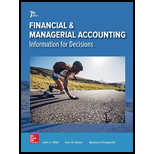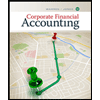
Concept explainers
Problem 1-2A Computing missing information using accounting knowledge A1 P1
The following financial statement information is from five separate companies.
| Company |
A
B
C
D
E
Required
- Answer the following questions about Company A.
- What is the amount of equity on December 31, 2016?
- What is the amount of equity on December 31, 2017? Check ( 1b) $41,500
- What is the amount of liabilities on December 31, 2017?
- Answer the following questions about Company B.
- What is the amount of equity on December 31, 2016?
- What is the amount of equity on December 31, 2017?
- What is net income for year 2017? ( 2c) $1,600
- Compute the amount of assets for Company C on December 31, 2017. (3) $55,875
- Compute the amount of stock issuances for Company D during year 2017.
- Compute the amount of liabilities for Company E on December 31, 2016.
1.
a.
To compute: The amount of equity, of A Company as on December 31, 2016.
Explanation of Solution
Given,
The amount of assets is $55,000.
The amount of liabilities is $24,500.
Formula to calculate equity is,
Substitute$55,000 for assets and $24,500 for liabilities.
Hence, the amount of equity of A Company as on December 31, 2016 is $30,500.
b.
To compute: The amount of equity, of A Company as on December 31, 2017.
Explanation of Solution
Given,
The amount of assets is $58,000.
The amount of equity is $30,500.
Stock issuance is $6,000.
Net income is $8,500.
Cash dividend is $3,500.
Formula to calculate equity is,
Substitute $30,500 for equity in the beginning,, $6,000 for issue of stock, $8,500 for net income, $3,500 for dividend.
Hence, the amount of equity of A company as on December 31, 2017 is $41,500.
c.
To compute: The amount of liabilities, of A Company as on December 31, 2017.
Explanation of Solution
Given,
The amount of assets is $58,000.
The amount of equity is $41,500.
Formula to calculate liabilities is,
Substitute $58,000 for assets and $41,500 for equity.
Hence, the amount of liabilities of A company as on December 31, 2017 is $16,500.
2.
a.
To compute: The amount of equity, of B Company as on December 31, 2016.
Explanation of Solution
Given:
The amount of assets is $34,000.
The amount of liabilities is $21,500.
Formula to calculate equity is,
Substitute $34,000 for assets and $21,500 for liabilities.
Hence, the amount of equity of B Company as on December 31, 2016 is $12,500.
b.
To compute: The amount of equity, of B Company as on December 31, 2017.
Explanation of Solution
Given,
The amount of assets is $40,000.
The amount of liabilities is $26,500.
Formula to calculate equity is,
Substitute$40,000 for assets and $26,500 for liabilities.
Hence, the amount of equity of B Company as on December 31, 2017 is $13,500.
c.
To compute: The net income, of A Company as on December 31, 2017.
Explanation of Solution
Given:
The amount of equity is $12,500 of December 31, 2016.
The amount of equity is $13,500 of December 31, 2017.
Stock issuance is $1,400
Cash dividend is $2,000
Formula to calculate net income is,
Substitute $12,500 for equity in the beginning, $1,400 for issue of stock,$13,500 for equity at the end, $2,000 for dividend.
Hence, the net income of B Company as on December 31, 2017 is $1,600.
3.
To compute: The amount of assets, of C Company as on December 31, 2017.
Explanation of Solution
Given,
The amount of liabilities is $29,000 as on December 31, 2017.
The amount of equity is $26,875 as on December 31, 2017.
Formula to calculate asset is,
Substitute$29,000 for liabilities and $26,875 for equity.
Working notes:
Calculation of the amount of equity as on December 31, 2016,
Calculation of the amount of equity as on December 31, 2017,
Hence, the amount of asset of C Company as on December 31, 2017 is $55,875.
4.
To compute: The amount of stock issuance, of D Company as on December 31, 2017.
Explanation of Solution
Given,
The amount of equity is $20,000 of December 31, 2016.
The amount of equity is $61,000 of December 31, 2017.
Net income is $14,000.
Formula to calculate stock issuance is,
Substitute $20,000 for equity in the beginning, $14,000 for net income, $61,000 for equity at the end.
Working notes:
Calculation of the amount of equity as on December 31, 2016,
Calculation of the amount of equity as on December 31, 2017,
Hence, the amount of stock issuances of D company as on December 31, 2017 is $27,000.
5.
To compute: The amount of liabilities of E Company as on December 31, 2016.
Explanation of Solution
Given,
The amount of assets is $119,000 as on December 31, 2016.
The amount of equity is $27,500 as on December 31, 2016.
Formula to calculate equity is,
Substitute $119,000 for assets and $27,500 for equity.
Working notes:
Calculation of the amount of equity as on December 31, 2017,
Calculation of the amount of equity as on December 31, 2016,
Hence, the amount of liabilities of E company as on December 31, 2016 is $91,500.
Want to see more full solutions like this?
Chapter 1 Solutions
Financial and Managerial Accounting
- Refer to the 10-K reports of Under Armour, Inc., and Columbia Sportswear that are available for download from the companion website at CengageBrain.com. Required: Which accounts on the balance sheet and income statement of each company may require adjusting entries? Would these accounts require accruals or deferrals?arrow_forwardBalance sheet Using the following data for Ousel Travel Service as well as the retained earnings statement shown in Practice Exercise 1-5A, prepare a balance sheet as of November 30, 2016: Accounts payable 62,500 Accounts receivable 186,000 Cash 308,000 Land 480,000 Supplies 16,500arrow_forwardExercise 1-35 Accounting Concepts OBJECTIVE 06° A list of accounting concepts and related definitions is presented below. Concept Definition 1. Revenue a. Owners claim on the resources of a company 2, Expense b. The difference between revenues and expenses 3. Net income (1055) c. Increase in assets from the sale of goods or services 4, Dividend d. Economic resumes of a company 5. Asset e. Cost of assets consumed in the operation of a business 6, Liability f. Creditors' claims on the resources of a company 7. Stock holders, equity g. Distribution of earnings to stockholders Required: Match each of the concepts with its corresponding definitionarrow_forward
- Analyze Pandora Media Pandora Media, Inc. (P) provides Internet music platform services in North America. Pandoras income statements through operating income for two recent years are as follows (in thousands): Pandora Media. Inc. Income Statements For the Years Ended January 31 (in thousands) Year 2 Year 1 Revenues: Advertising 1,072,490 933,305 Subscription 225,786 220,571 Ticketing service 86,550 10,167 Total revenues 1,384,826 1,164,043 Expenses: Cost of revenues (894,922) (697,341) Sales and marketing (491,4SS) (175,572) (141,636) (1,703,585) (398,169) (153,943) General and administrative Product development (84,581) (1334,034) Total expenses Operating income (loss) (318,759) (169,991) a. Prepare a vertical analysis of the two income statements. b. Interpret the vertical analysis.arrow_forwardMissing amounts from financial statements The financial statements at the end of Wolverine Realtys first month of operations are as follows: Chapter 1 Introduction to Accounting and Business 47 Instructions By analyzing the interrelationships among the four financial statements, determine the proper amounts for (a) through (r).arrow_forwardMissing amounts from financial statements The financial statements at the end of Atlas Realtys first month of operations follow: Atlas Realty Income Statement For the Month Ended May 31,2016 Fees earned 400,000 Expenses: 300,000 Wages expense (a) Rent expense 48,000 Supplies expense 17,600 Utilities expense 14,400 Miscellaneous expense.. 4,800 Total expenses 288,000 Net income (b) Atlas Realty Retained Earnings Statement For the Month Ended May 31,2016 Retained earnings, May 1,2016 (c) Net income (d) Less dividends (e) Increase in retained earnings (f) Retained earnings, May 31, 2016 (g) Atlas Realty Balance Sheet May 31,2016 Assets Liabilities Cash 123,200 Accounts payable100,000 48,000 Supplies 12,800 Stockholders Equity Land (h) Common stock (j) Retained earnings (k) Total stockholders equity (i) Total liabilities and Stockholders equity Total assets (i) (m) Atlas Realty Statement of Cash Flows For the Month Ended May 31, 2016 Cash flows from operating activities: Cash received from customers (n) Deduct cash payments for expenses and payments to creditors (252,800) Net cash flows from operating activities (o) Cash flows used for investing activities: Cash payments for acquisition of land (120,000) Cash flows from financing activities: Cash received from issuing common stock (160,000) Deduct cash dividends (64,000) (o) Net cash flows from financing activities (P) Net increase (decrease) in cash and April 30, 2016, cash balance (q) Instructions By analyzing the interrelationships among the four financial statements, determine the proper amounts for (a) through (q).arrow_forward
 Cornerstones of Financial AccountingAccountingISBN:9781337690881Author:Jay Rich, Jeff JonesPublisher:Cengage Learning
Cornerstones of Financial AccountingAccountingISBN:9781337690881Author:Jay Rich, Jeff JonesPublisher:Cengage Learning Corporate Financial AccountingAccountingISBN:9781337398169Author:Carl Warren, Jeff JonesPublisher:Cengage Learning
Corporate Financial AccountingAccountingISBN:9781337398169Author:Carl Warren, Jeff JonesPublisher:Cengage Learning Financial & Managerial AccountingAccountingISBN:9781285866307Author:Carl Warren, James M. Reeve, Jonathan DuchacPublisher:Cengage Learning
Financial & Managerial AccountingAccountingISBN:9781285866307Author:Carl Warren, James M. Reeve, Jonathan DuchacPublisher:Cengage Learning Corporate Financial AccountingAccountingISBN:9781305653535Author:Carl Warren, James M. Reeve, Jonathan DuchacPublisher:Cengage Learning
Corporate Financial AccountingAccountingISBN:9781305653535Author:Carl Warren, James M. Reeve, Jonathan DuchacPublisher:Cengage Learning



